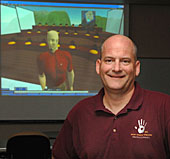Virtual worlds make real life marketing business sense, says Iowa State professor
07-28-08

Gut Noel, the avatar fos Iowa State business professor Brian Mennecke, checks out the Adidas store in Second Life.
Contacts:
Brian Mennecke, Management Information Systems, (515) 294-8100, mennecke@iastate.edu
Dan Ryan, College of Business, (515) 294-5800, djr@iastate.edu
Mike Ferlazzo, News Service, (515) 294-8986, ferlazzo@iastate.edu
Virtual worlds make real life marketing business sense, says Iowa State professor
AMES, Iowa -- There are businesses making real money selling products in virtual worlds like Second Life. But even if owners don't want to sell their wares to avatars in those virtual worlds, an Iowa State University business professor says they should at least consider exploring their product development and marketing value.
Why else would Toyota recently debut a virtual edition of its Scion xB for Second Life residents to test drive online?
Brian Mennecke, an associate professor in management information systems in ISU's College of Business, says in many ways, virtual worlds such as Second Life provide customers with a very similar experience to that of a "real" store. And it's likely that these game-like tools will soon be integrated into common Internet activities like searching for, evaluating and purchasing products.
Some already are. Mennecke reports that Sears worked with IBM to build a virtual store that could create realistic representations of a customer's kitchen or bathroom. It not only allows a customer to visualize how Sears products might look or fit in the home, but it also allows Sears to examine when and how its products succeed or fail.
3D enhances the online experience
"This is important because size, color and other tactile characteristics matter to all of us," said Mennecke, who has conducted research and taught courses in Second Life. "If you visit a Web site to buy a camera, you'll likely want to see many images of the camera from various angles so that you can sense what the camera looks like, how big it is, where the controls are arranged, etc. Of course, it will still be some time before the online experience can provide customers with a sense of actually holding a product, feeling its weight, or sensing its texture, but the 3-D nature of virtual worlds will significantly enhance the way that businesses can engage with their customers."
Because virtual worlds offer businesses the opportunity to present products -- both existing products and those under development -- in engaging and interactive ways, Mennecke says these online spaces will increasingly be important for businesses as places to design, develop and evaluate new product offerings. As an example, he reports that Starwood Hotels & Resorts used Second Life more than a year ago to evaluate a new design for one of its hotel brands.
"By allowing anyone who used Second Life to visualize the floor plans, colors, aesthetics and other characteristics of the proposed designs, Starwood was able to conduct what amounted to virtual focus groups to garner feedback and suggestions for improving the designs for the new hotel brand," Mennecke says.
By prototyping new products and services in a virtual world like Second Life -- an environment that currently includes 14.5 million residents (http://secondlife.com/whatis/economy_stats.php) -- Mennecke theorizes that a firm can save time and money and garner richer and more accurate feedback. He says even small businesses have great opportunities to leverage the 3-D characteristics of these environments for designing and selling both real and virtual products.
Small businesses thrive in virtual worlds
"The economy in Second Life, for example, is largely driven by activity from small businesses and entrepreneurs," Mennecke said. "Small businesses thrive in virtual worlds because they often are sufficiently nimble to identify business opportunities, develop solutions and respond quickly."
According to Mennecke, large businesses like IBM have demonstrated that virtual worlds can be effective for testing and refining product offerings. And the same product tests and refinements can be undertaken by small businesses on a smaller scale.
"For example, a small T-shirt business could test its unique designs in Second Life by selling them or giving them away," he said. "In a virtual world, copying, distributing and evaluating an article of clothing costs almost nothing. Plus, virtual products can be designed so that they can be tracked and monitored -- for instance, the T-shirt's popularity can be evaluated. Viral marketing, product testing, feedback, and product refinements can all be undertaken in virtual worlds for a fraction of the cost of similar testing and marketing in the real world."
He says it all adds up to real world savings, and sometimes earnings, for those entrepreneurs who can extend their business reach into the virtual worlds.
Summer course uses Second Life
Mennecke is using Second Life to teach portions of his summer course, "Organizational Applications of Collaborative Technologies and Social Media" (http://www.bus.iastate.edu/mennecke/594/Summer08/). Graduate students and corporate professionals are enrolled in the course, which is being taught through a variety of social media tools.
-30-
